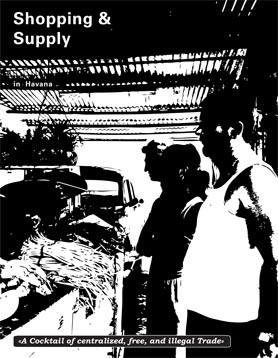Shopping & Supply in Havana

Students: Stephan Achermann & Andri Werlen
Location: Group work in Havana
Date: June, 2007
Type: Research project, student work, shopping and supply (Decentralized Centers)
The 1959 revolution had a large impact on the structure of commerce in the city of Havana as well. As the entire system of production and ownership was transformed, it resulted in a different organization of supplies in the city. Only a few commercial streets that existed in Havana before the revolution continue with their function to the present day. In neighborhoods such as Deep Havana (eg. Dies de Octubre), commercial thoroughfares of the city were converted to housing. Revolutionary time brought centralized production and distribution. A subsidized system for food where every registered family is entitled to basic provisions, la canasta basica, exists to this day, even though there is a growing recognition that not all the citizens need it.
Since periodo especial, economic liberalization has again brought more small-scale trade into the city. Much of these services, even kiosks, are state organized and managed while some exceptional forms of private entrepreneurship are allowed.
This era has also introduced a duality into the commercial field due to double currency: ‘CUC shops’ are to be found along the primary city streets or on important crossings. In different commercial sectors state companies are organized based on the CUC, peso convertible and therefore difficult for much local population to access: TRD (Tiendas Recuperacion de Divisas – ‘Shops for Obtaining Foreign Currency’), Panamericana (food and everyday goods chain), Artex (souvenirs and handicraft chain), among others. Many products, such as clothes can only be obtained in peso convertible. Deeper in the neighborhoods the currency is peso national and one encounters a quite equal distribution of small shops, sometimes informal. Bodegas are a system of corner shops that cover certain neighborhood radiuses; Mercados Agro-pecuarios are self-sustainable neighborhood markets for agricultural products that appeared in the beginning of the 90s. Urban agriculture is very present, inside as well as around the city in its green belt, supported by a strong governmental policy. In a kind of a paradoxical turn, the presence of fertile land inside and around the city solves the otherwise acute problem of transport: fruits, vegetables and other foods can often be produced and traded practically on the same spot.
Since periodo especial, informal economy is also a growing phenomenon, having various impacts on the urban reality of Havana. On one hand there is informal transformation of housing, privatization of public space, but also housebound informal production, informal trade, as well as numerous financial informal strategies of meetings one’s needs in the double currency system. Once highly centralized city commerce has today become highly decentralized.
In the main focus of this research are the particularities of the shopping and supply in Havana, a city where the highly controlled market economy, general immobility, embargo, poverty, informality and dual currency combine to produce a specific commercial system.
Download the Book PDF

